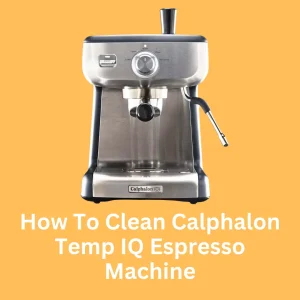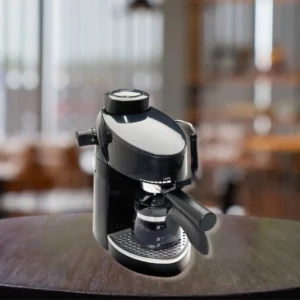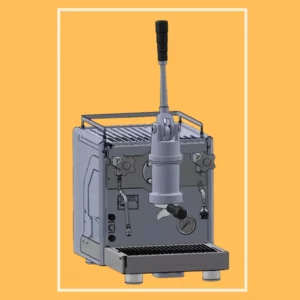Affiliate Disclaimer
As an Amazon Associate, I earn from qualifying purchases. It supports the website. So, Thank you. ❤️
Are you trying to find the best boiler system before buying your new espresso machine? If so, then you’ve just hit the right spot. I have come up with a complete guide on the comparison of dual boiler vs. single boiler vs. heat exchanger espresso machine.
You know that boilers are the best option when choosing an espresso machine. Apparently, there are 4 types of boilers found on espresso machines, which are Thermoblock, Dual Boilers, Single Boilers, and Heat Exchangers. But which boiler should you consider choosing that will best fit your needs?
Simply answered, if you are a coffee freak and need a ton of shots daily, then dual boilers espresso machines are the best way to go. On the other hand, you can try out a single boilers espresso machine if you drink 2-3 cups of coffee on a regular basis, and for a better experience, try the heat exchangers espresso machine.
What Is A Single Boiler Espresso Machine?
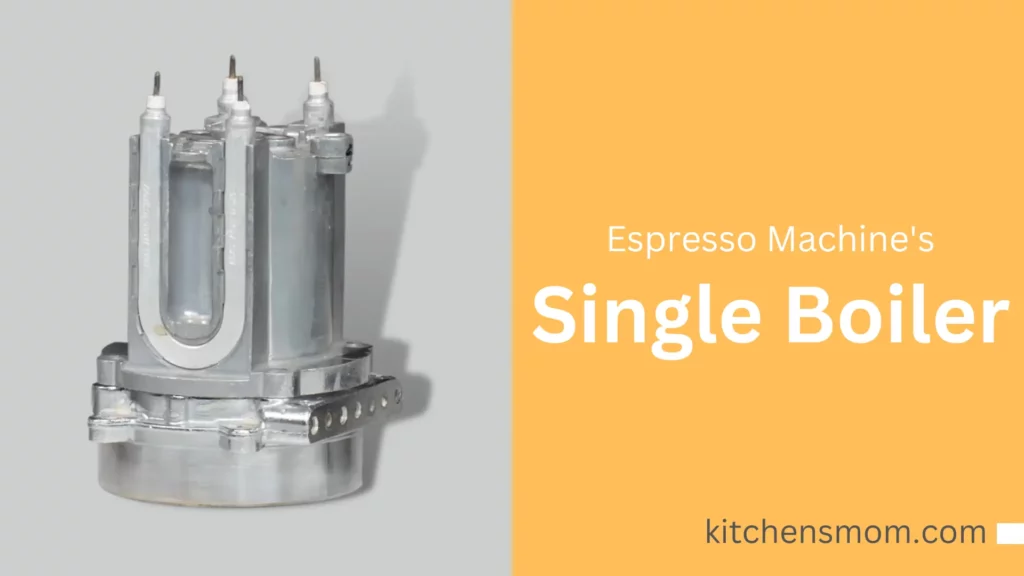
Single-boiler espresso makers steam milk and also brew coffee in the same pot. These machines are convenient for use in smaller kitchens because of their speed and tiny size when preparing coffee.
In single boilers, you can brew and steam milk in the same pot, but not at the same time. For this reason, you have to wait for some time to get the finished coffee.
If you drink espresso regularly but rarely need to steam milk, or if you enjoy milkshakes but limit yourself to one or two per day, then single-boilers should not be a problem for you. One-boiler devices are the norm for entry-level espresso makers.
How Does A Single Boiler Espresso Machine Work?

Getting normalized with single boilers is easy. The boiler in single-boiler machines is heated by a single element controlled by thermostats. Each thermostat is programmed to a certain temperature range, which is perfect for brewing coffee. The other has a setting for boiling water and creating steam.
First of all, the boilers fill half of the tank. You will see the boiler and the group head temperature stabilize as the machine warms up. The temperature of the brew group will be between 198 to 204 degrees Fahrenheit, which depends on the machine and the settings.
After that, when the shot is withdrawn, the water is taken straight from the boiler, but the temperature stays the same. When you’re done shooting, you can turn the machine into steaming mode.
For milk foaming, the process begins with heating the boiler to a temperature where enough steam pressure might be generated. When it is up to 255 degrees, it will be ready for steaming. After the steaming process is over, the machine’s steam function can be turned off to allow it to cool to the brew temperature.
As the temperature rises and falls during steaming, it becomes less stable after brewing the first shot. It makes the subsequent shots less enjoyable, which results in a lack of flavor in the espresso. There is a little delay between pulling a shot and heating milk because of the different temperatures.
Is A Single Boiler Espresso Machine Worth It?
It depends on your requirements. If you drink 2-3 cups of coffee every day, this boiling system should not be a problem for you. They are quite affordable and also easy to use. Moreover, if any element gets damaged, you can find it very easily.
Lastly, they can also warm up the water very quickly, but the problem is that you have to wait for the finished coffee.
Pros
- These machines are very easy to cooperate with.
- They could be affordable, and easy to find.
- Brew temperature is controlled by a PID thermostat and can be altered separately from the steam temperature on PID-equipped equipment.
- Excellent for small homes and fewer coffee consumers.
- Takes less time to warm up than any other boiler.
Cons
- It takes a long time compared to other boilers to produce coffee
- Reduced control over brew temperature, especially when serving several beverages.
- The boilers of single-boiler machines are typically smaller and provide lower steam pressure.
- Not enough fresh water flows through the container as other boilers
What Is A Dual Boiler Espresso Machine?
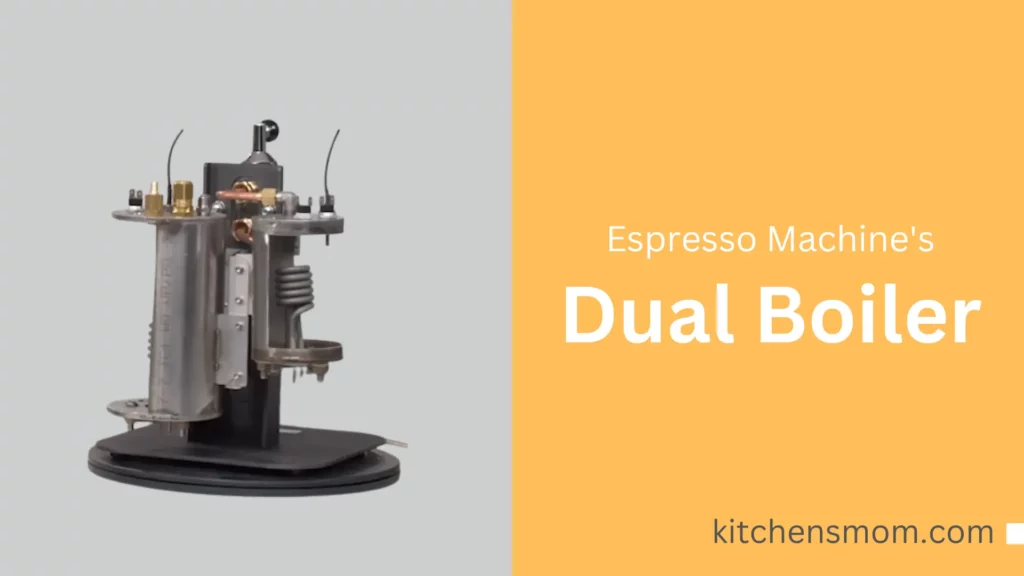
There are basically 2 boilers in a dual espresso machine. The two boilers in a dual boiler machine are used for different purposes: one for brewing, the other for steaming.
That means that you can make espresso and steam at the same time at any moment after the machine has heated up.
To provide consistent shots and precise brew temperatures, nearly all dual boilers have a PID. Since changing water temperatures can produce distinctive flavor profiles, the PID enables users to make modifications based on the type of coffee.
How Does A Dual Boiler Espresso Machine Work?
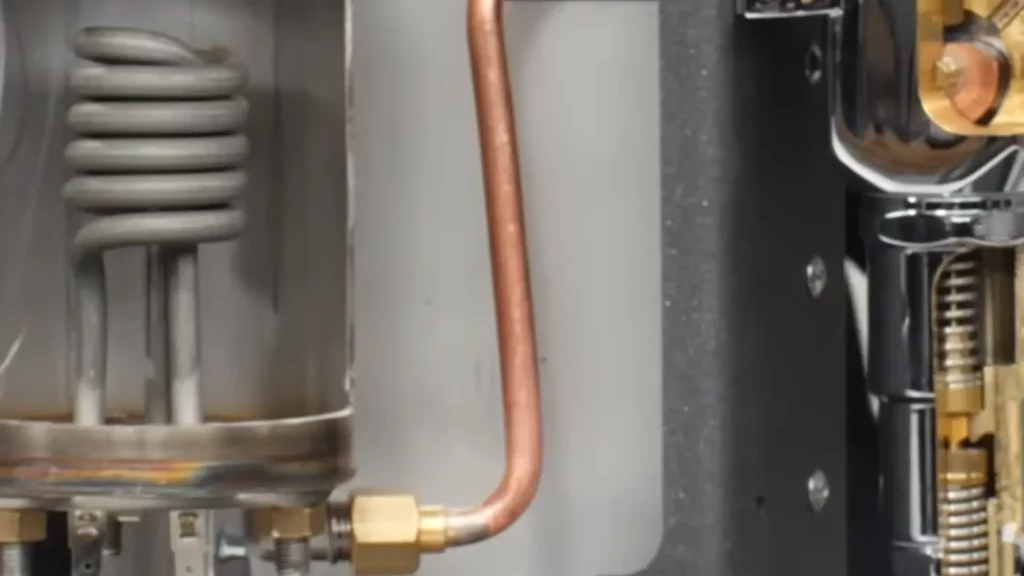
Dual boilers are easy to cope with. In this boiling system, both boilers are filled by pumping cold water from the reservoir or a direct water line hookup into them.
The steam boiler is where water is heated to steam temperature. The water in the brew boiler is brought up to brewing temperature. Each boiler has its own thermostat, allowing for precise temperature control.
You do not need to frequently wait between shots. Because the brew boiler and group head maintain a consistent temperature after the first one is extracted, they need less time.
Depending on the machine, there may be a brief period of rest after steaming milk for one drink. But in most cases, milk for a different drink can be steamed immediately thereafter.
Is A Dual Boiler Espresso Machine Worth It?
Only those who plan to drink at different brew water temperatures and value rapid heating time will benefit from a dual boiler.
Dual boiler coffee makers are equipped with two boilers, one for brewing coffee and one for frothing milk. This permits elevated steam pressure and more precision in regulating the temperature of the brewing water.
Hence, fans of the coffee beverage will find this equipment indispensable. A dual boiler is ideal if brewing coffee is as much of a pastime as it is a daily habit.
Pros
- Its steam and brew temperatures can be adjusted separately.
- It is super simple for PID-equipped machinery.
- You can brew and steam simultaneously with no breaks in between.
- There is less effort needed to maintain a steady brewing temperature from one serving to the next.
- No coolant flush is needed.
Cons
- Additional complexity and pieces are required in the design.
- Boiler water is used for brewing instead of water from the storage tank.
- More time is required to reach an acceptable temperature after starting up, compared to a single boiler or heat exchanger.
What Is A Heat Exchange Espresso Machine Boiler?
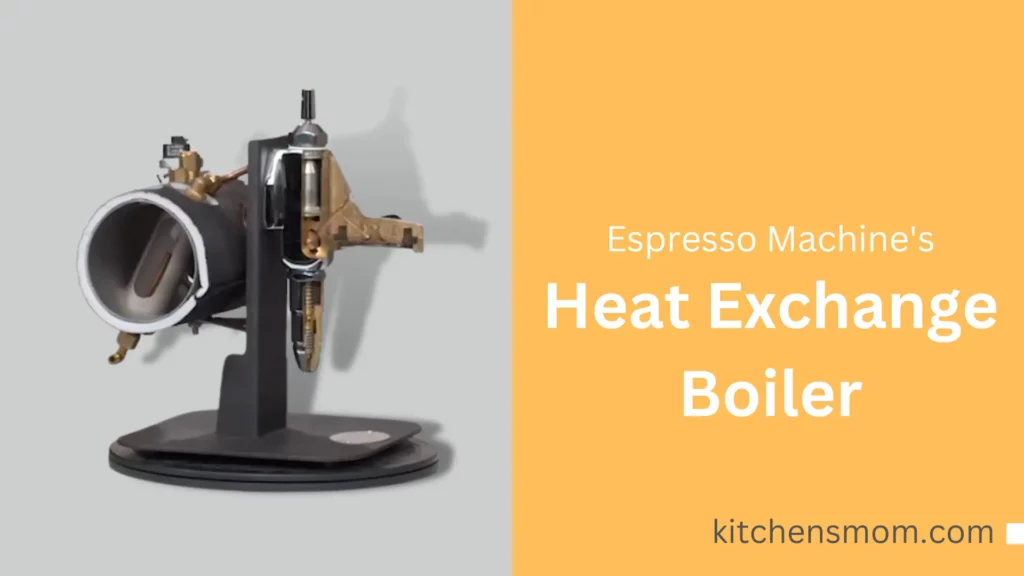
Dual boiler machines and heat exchanger machines both allow you to steam milk and make espresso, but they operate in different ways.
In a heat exchanger, there is only one boiler, which is used for steam and hot water, and a copper pipe runs through it. This pipe is used to pull cold water and heat it to the correct temperature for espresso.
Heat exchange espresso machines include a heat exchanger system, where brewed water gets heated by a steam boiler.
How Does A Heat Exchange Espresso Machine Boiler Work?
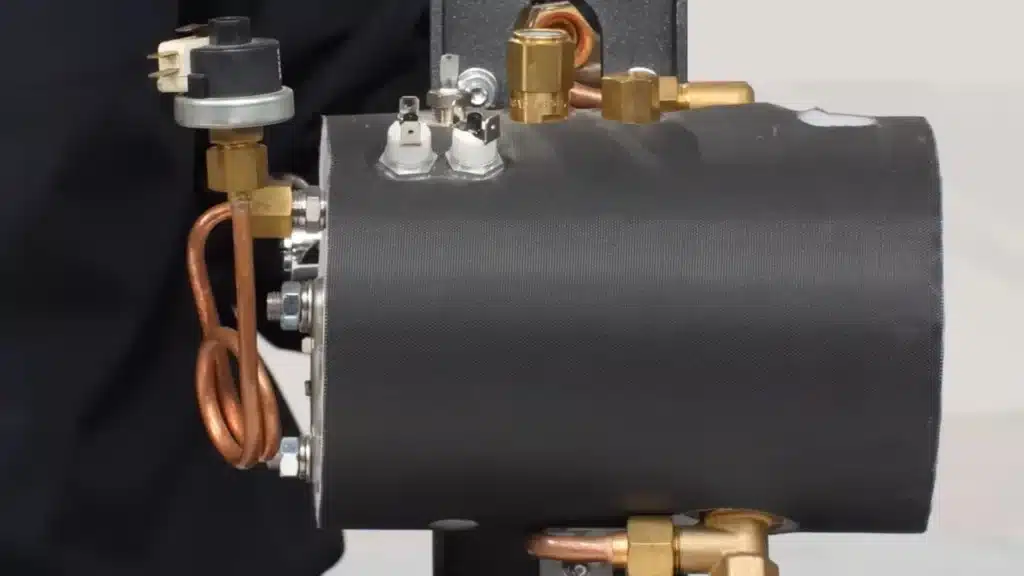
The heat exchanger boiler receives a steady supply of cold water from the water source. With the help of the boiler, the water is brought up to steam temperature, or roughly 255 degrees. After turning on the hot water tap, you can see the water coming straight from the steam boiler.
During the brewing process, the cold water source is connected directly to the brew group. That is how the water is drawn from it when a shot is pulled. The boiler has a tube inside of it in order to get the brewing water to steam temperature. A flash heating system brings the liquid to brew temperature as it flows down the tube.
After a brew cycle, the remaining water in the tube gets stored because of reaching the steam temperature. As a result, a cooling flush is necessary just before the shot is taken.
The water temperature in the steam boiler is regulated by a PID temperature controller or a thermostat. Brew temperatures can’t be adjusted directly with these because water is heated as it travels down the tube. But it can be adjusted in a roundabout way by changing the steam boiler’s temperature.
Is A Heat Exchanger Espresso Machine Worth It?
If you are willing to buy an espresso machine that will give better service than single boilers and is more affordable than double boilers, then heat exchangers are for you. You can get them at a very reasonable price with many qualities, sometimes even more than dual boilers.
Pros
- Since only one boiler needs to be heated in a Heat Exchanger machine, it can save energy more than dual boilers.
- Water for brewing does not have to be heated in a boiler before being used. When used for brewing, this newer water is likely to have a more robust flavor, especially if mineral deposits are present in the boiler.
- A heat exchanger machine’s recovery and warm-up times are faster than those of a double boiler espresso machine.
- Lower in price than the dual boiler, and also the servicing cost is low.
- It has cleaner brewed water because it obtains water straight from the freshwater reservoir rather than heating it in a boiler.
Cons
- There is no separation between the temperature controls used for brewing and steaming.
- Since the brew water temperature is not under the user’s direct control in heat exchanger machines, adjusting the steam pressure will also affect the brew water temperature.
- Cooling flushes are required for heat exchanger espresso machines, which flush the group head before brewing a shot.
Dual Boiler vs Single Boiler vs Heat Exchanger Boiler:
Espresso machines with boiling systems are a great way to get good coffee. But the question that often arises is which boiler should you use? What could be the best option for you?
Below, according to their specifications, I have covered all the information that differentiates these 3 boilers from each other.
To make it easier, I have created a comparison box between all the boilers. Let’s find out which one you need.
| Boilers | Single Boiler | Heat Exchanger | Dual Boiler |
| High-Temperature | Less | Yes | No |
| Save Energy | Yes | Average | No |
| Time | More | Average | Less Time |
| Clean Water | Less | Average | More |
| Coolant | No | Yes | No |
| Affordability | More | Average | More |
Single Boiler vs Double Boiler Espresso Machine
Dual boiler espresso machines can brew coffee and steam milk at the same time, maintaining an even temperature. They also have large enough boilers to handle multiple beverages at once.
On the other hand, coffee preparation with a single boiler machine is the slowest because of the time required to switch between brewing and steaming. Due to this change, single boilers are now typically constructed with smaller boilers and can’t simultaneously brew a large volume of drinks.
If you have a small family and have a few requirements for coffee per day, you can go for single boilers. But if you have a large family or more demand for coffee then dual boilers can give you a better result.
Single Boiler vs Heat Exchanger Espresso Machine
Heat exchangers are not very different from single boilers. Both of the boilers have one boiler, but the heat exchangers have an additional tube in the boiler.
Unlike a single boiler, a heat exchange machine may simultaneously brew and steam because the brew and steam water have independent water paths. They have a single large boiler with a central heat exchange line that feeds the group head.
Heat Exchanger vs Dual Boiler Espresso Machine
A dual boiler includes a separate boiler meant for making espresso, which is their best quality. This necessitates that the temperature profile of multiple boilers be relatively constant and linear.
But in heat exchangers, the temperature is expected to fluctuate slightly during the extraction process. Idling causes the water in the heat exchanger to gradually increase in temperature. When an extraction is made, cold water enters the heat exchanger and is heated as the hot water leaves.
Pro Advice:
- If you are less addicted to coffee and have a small environment, you can go for single boilers with no hesitation.
- If you are addicted to coffee but do not worry about the higher temperature, then the heat exchanger could be the perfect one for you. It can give better service than a single one.
- Lastly, dual boilers are for you if you frequently drink coffee or milkshakes i.e. more than 5 times a day.
Kinel’s Observation
Well, that’s all there is to it, people. Now that you’ve got a clear understanding of dual boilers vs. single boilers vs. heat exchangers.
To wrap it all up, if you need to choose the best boiler for you, then go for what you actually need. For example, if the demand is 2-4 cups, then there is no need to buy a dual boiler. You can buy a single boiler as you can also get it at a very affordable price. Moreover, it is also used by most people because of its wide variety of benefits.

